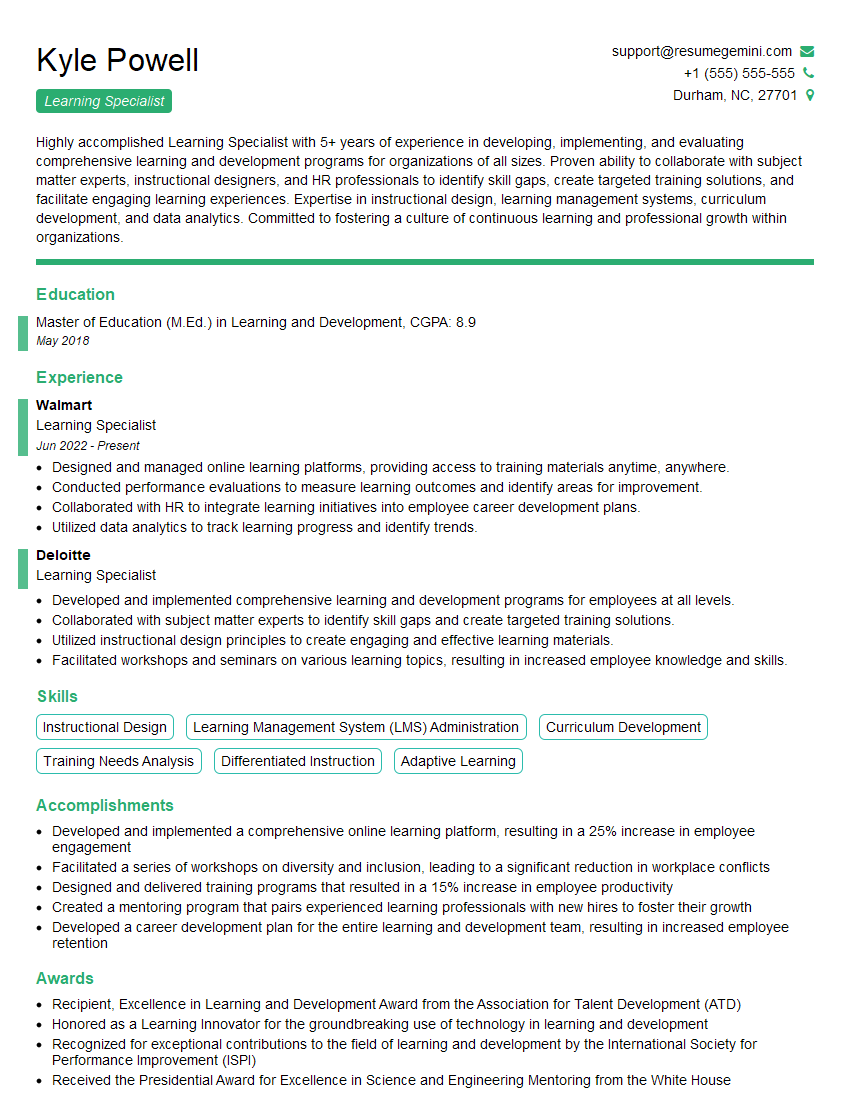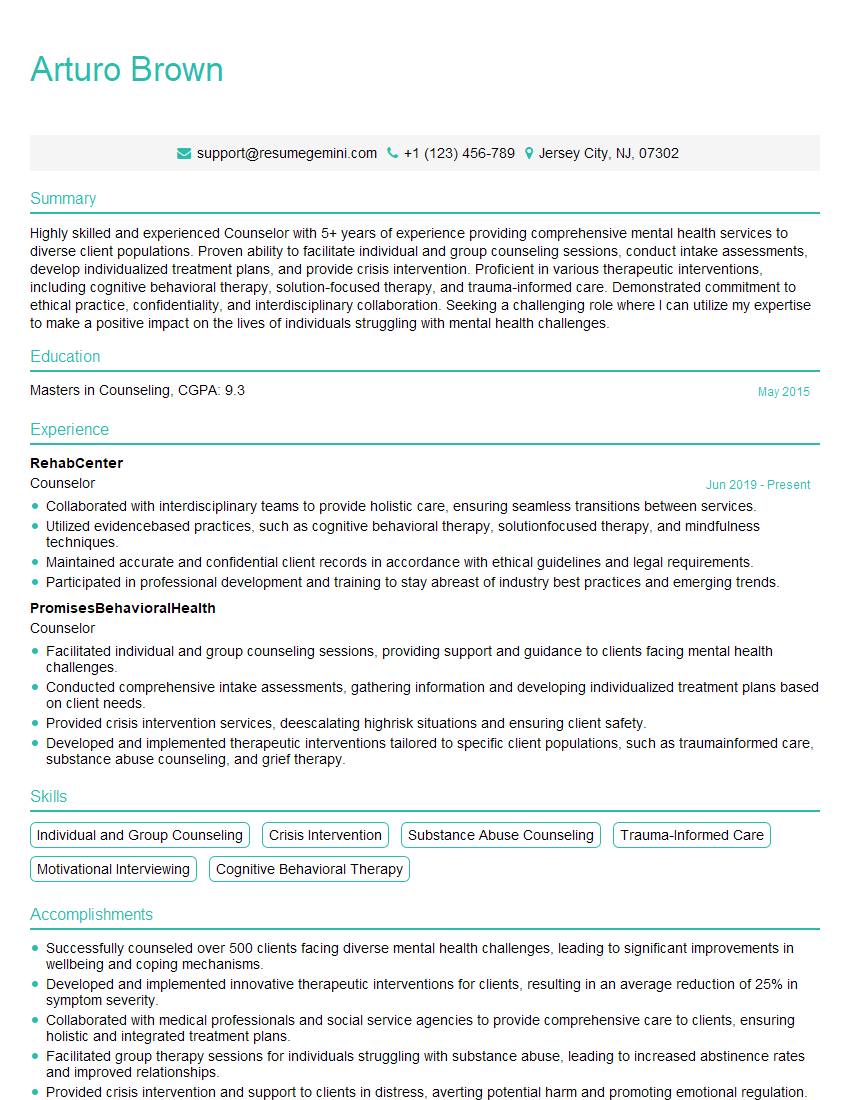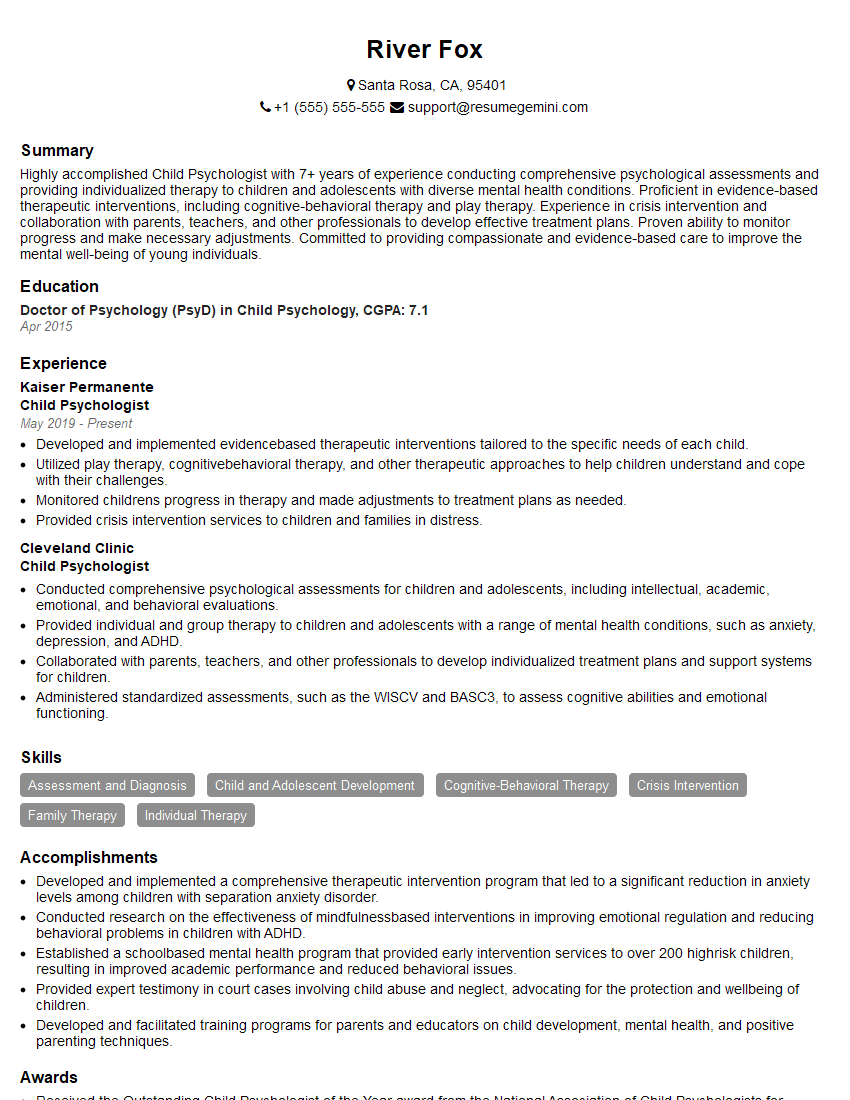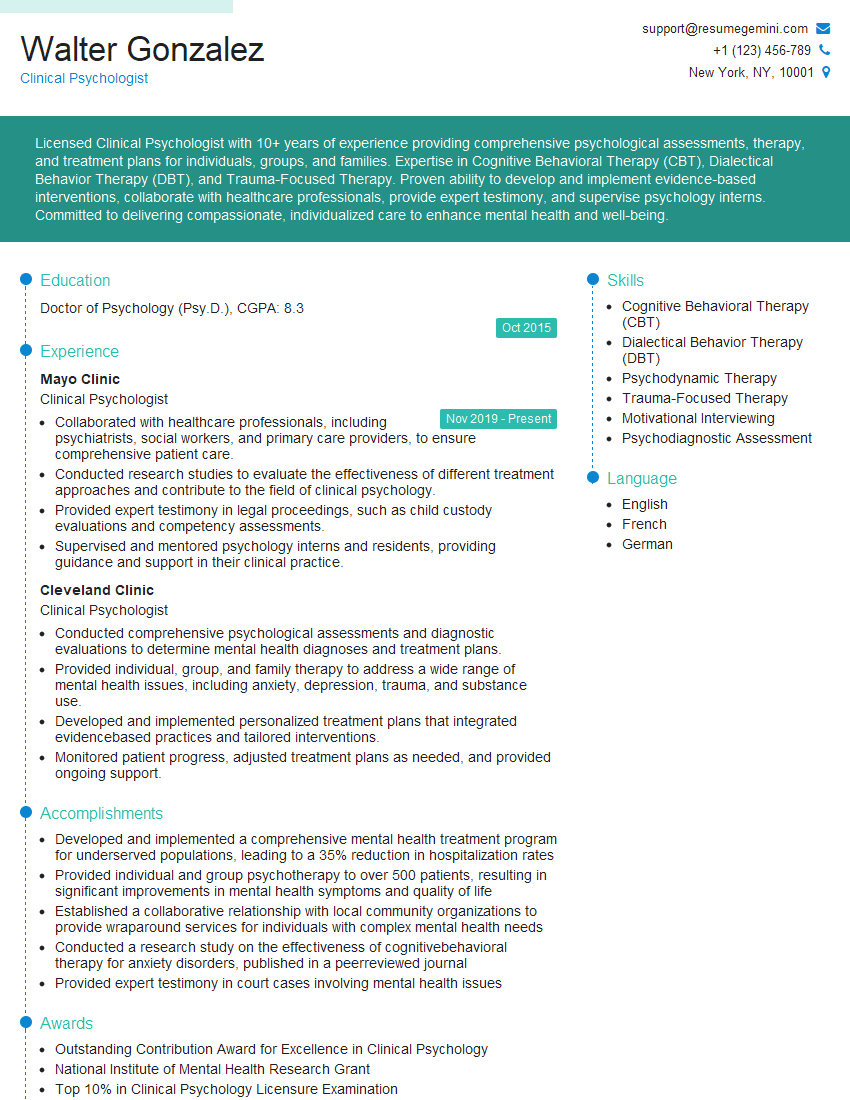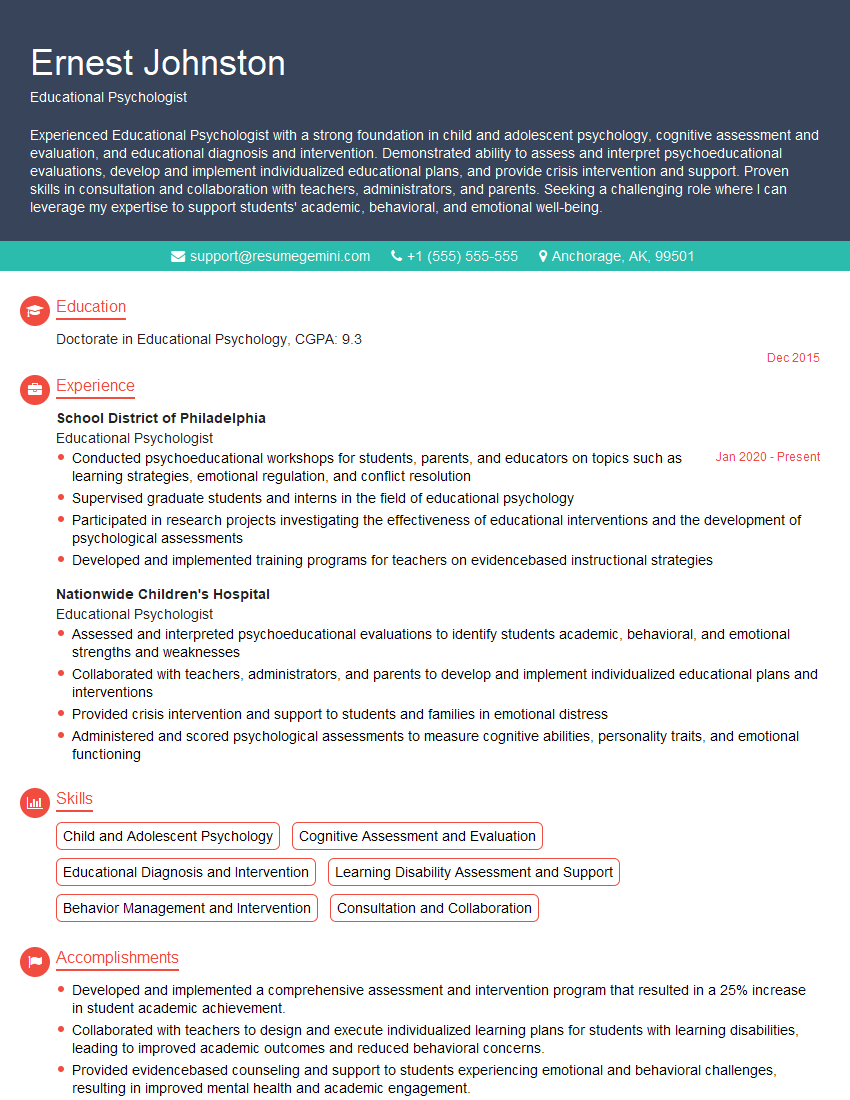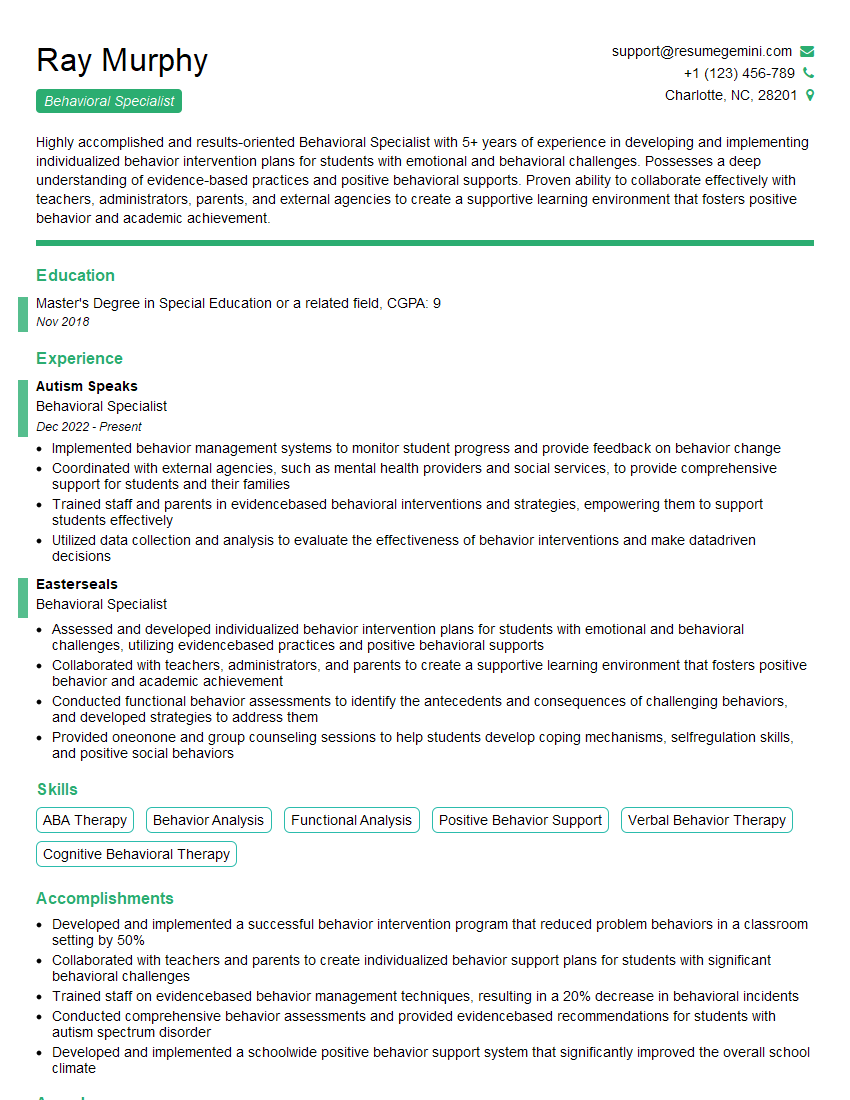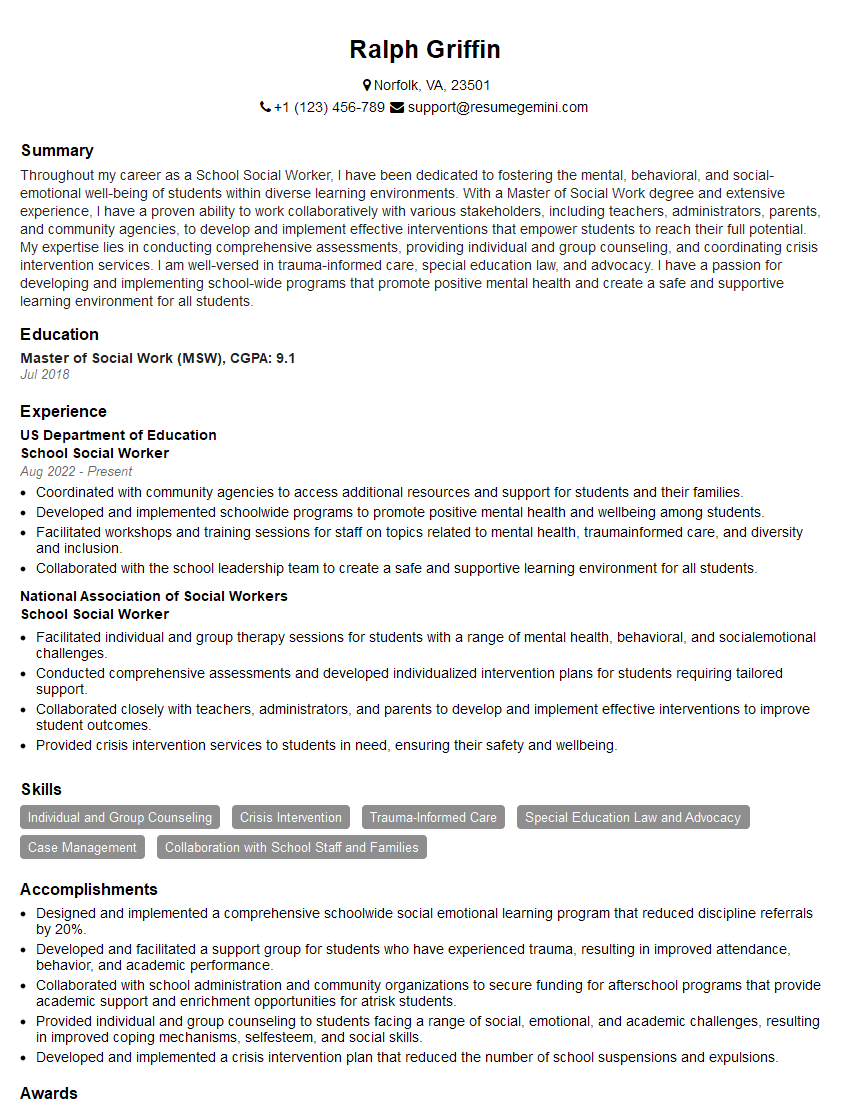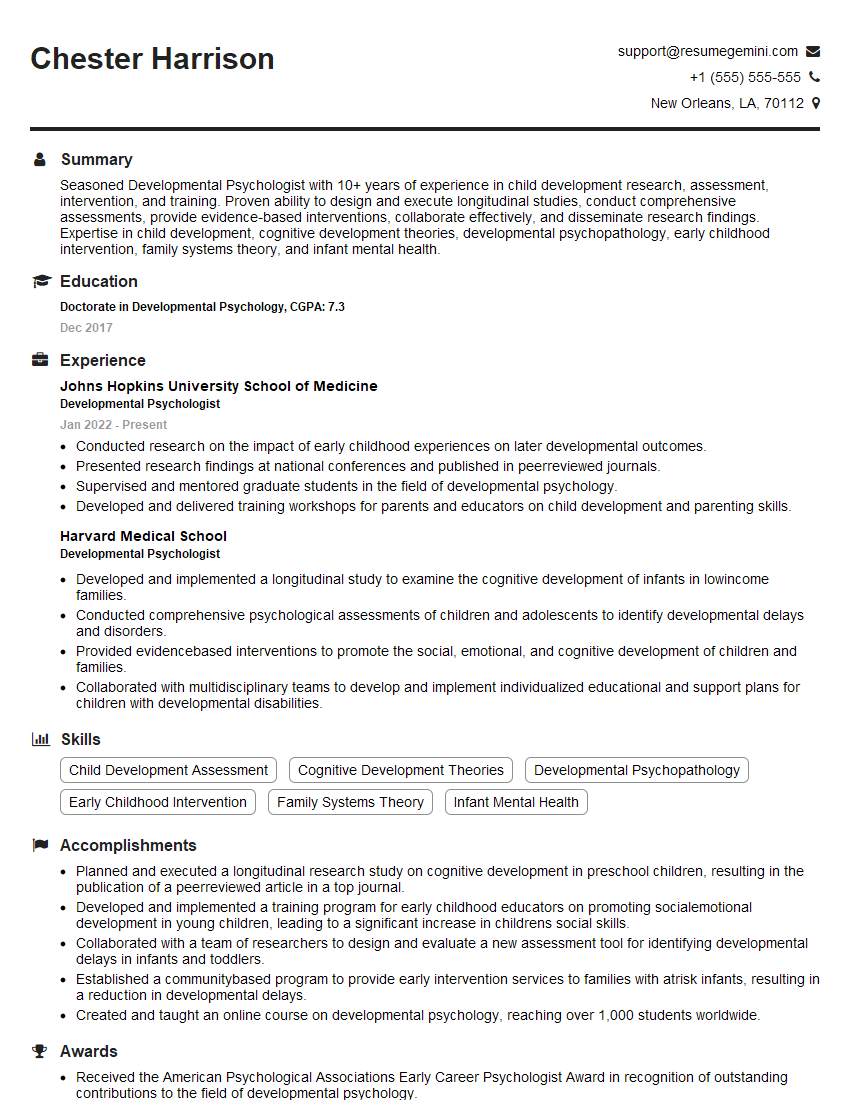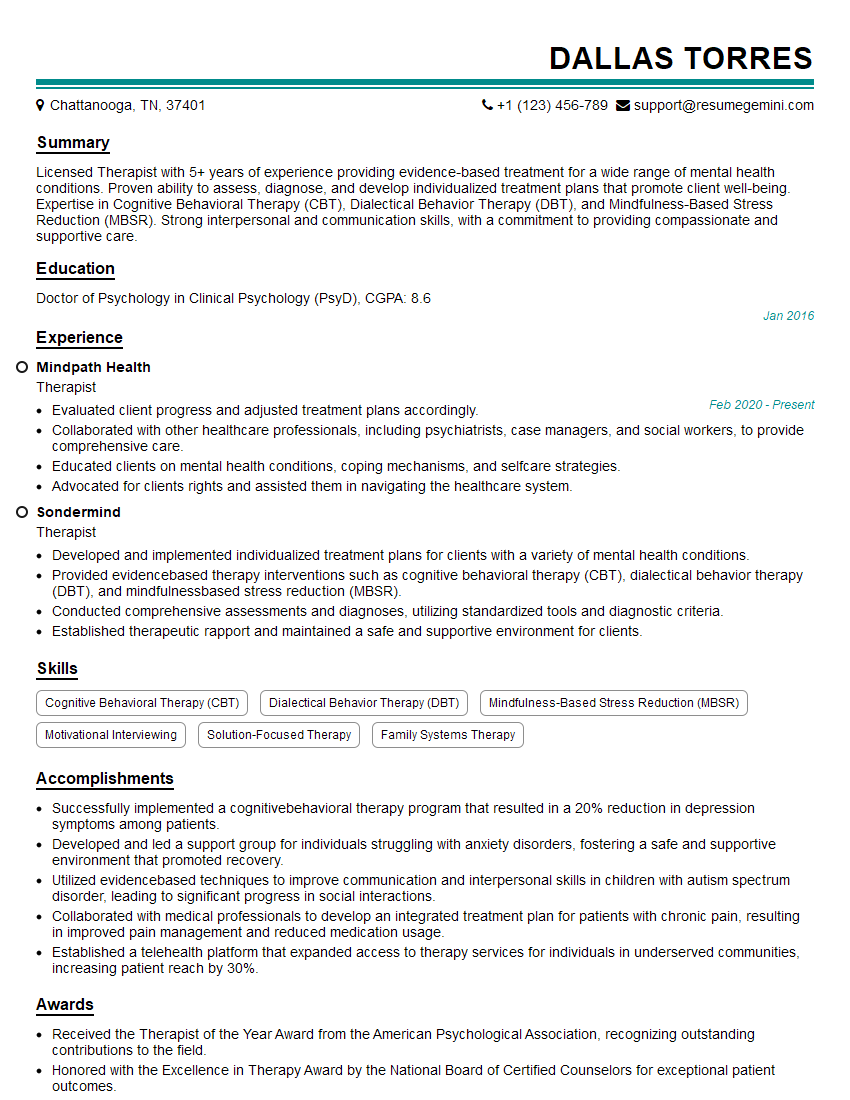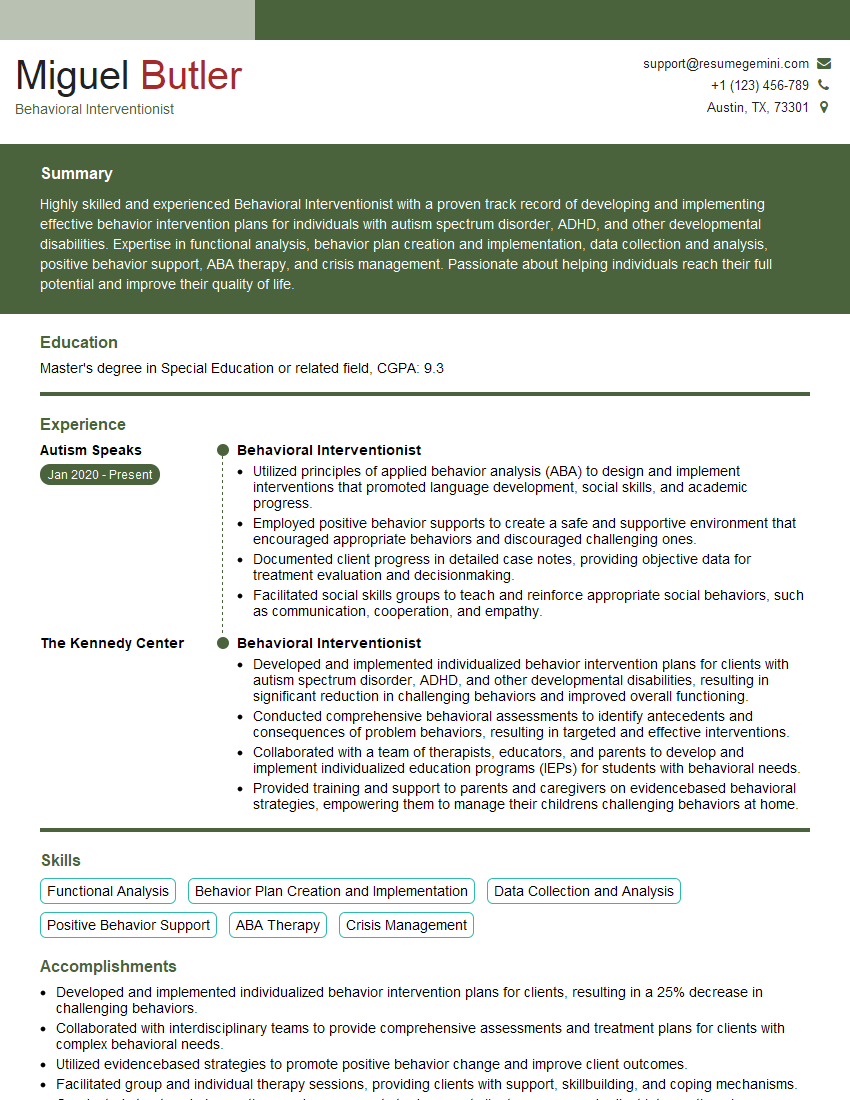The right preparation can turn an interview into an opportunity to showcase your expertise. This guide to Social-Emotional Assessment interview questions is your ultimate resource, providing key insights and tips to help you ace your responses and stand out as a top candidate.
Questions Asked in Social-Emotional Assessment Interview
Q 1. Explain the difference between social-emotional learning (SEL) and social-emotional assessment.
Social-emotional learning (SEL) and social-emotional assessment are intrinsically linked but distinct concepts. SEL refers to the process of developing the skills needed to understand and manage emotions, build positive relationships, make responsible decisions, and achieve personal and academic goals. Think of it as the ‘what’ – the skills we’re aiming to cultivate. Social-emotional assessment, on the other hand, is the ‘how’ – the methods we use to measure the level of these skills in an individual. It’s the systematic process of gathering information about a person’s social-emotional competencies to understand their strengths and areas for growth. For example, SEL might involve teaching children empathy through role-playing, while a social-emotional assessment might involve observing their interactions during a group activity to gauge their empathy skills in a real-world scenario.
Q 2. Describe three common methods used to assess social-emotional skills in children.
Three common methods used to assess social-emotional skills in children include:
- Observations: Directly observing a child’s behavior in various settings – classrooms, playgrounds, group activities – provides valuable insights into their social interactions, emotional regulation, and problem-solving skills. For instance, observing whether a child shares toys, responds appropriately to frustration, or participates effectively in group discussions.
- Self-report measures: Questionnaires, rating scales, or checklists completed by the child (age-appropriate versions) offer a first-hand account of their feelings, thoughts, and behaviors. These can include scales measuring self-esteem, anxiety, or social skills. However, it’s crucial to understand the limitations of self-reporting, especially in younger children.
- Informant reports: Gathering information from multiple sources such as parents, teachers, and peers provides a more comprehensive understanding. Teachers may be asked to complete rating scales indicating a child’s classroom behavior and social interactions, while parents might provide information on the child’s emotional regulation at home. Triangulating information from different sources helps reduce bias and increases the accuracy of the assessment.
Q 3. What are the key indicators of social-emotional challenges in adolescents?
Key indicators of social-emotional challenges in adolescents can manifest in various ways. Some common signs include:
- Increased irritability and mood swings: Significant and persistent shifts in mood, accompanied by anger outbursts or emotional lability.
- Withdrawal and isolation: Decreased engagement with friends and family, avoidance of social situations, and a general sense of loneliness.
- Difficulty regulating emotions: Inability to cope with stress, manage anxiety or anger effectively, leading to impulsive or self-destructive behaviors.
- Academic difficulties: Decreased academic performance due to lack of motivation, poor concentration, or difficulty managing emotions interfering with learning.
- Risk-taking behaviors: Engaging in substance use, risky sexual behavior, or other activities that put their health and safety at risk.
- Changes in sleep or appetite: Significant changes in sleeping patterns or appetite can also point towards underlying social-emotional struggles.
It’s important to note that these indicators should not be viewed in isolation. A comprehensive assessment considering various factors is crucial for a proper diagnosis.
Q 4. How do you interpret the results of a social-emotional assessment?
Interpreting the results of a social-emotional assessment is a nuanced process requiring clinical judgment and expertise. It involves carefully reviewing all gathered data – observations, self-reports, informant reports – to develop a holistic understanding of the individual’s strengths and challenges. This isn’t simply about assigning a label or score; it’s about creating a detailed profile that paints a picture of the individual’s social-emotional functioning. For example, a low score on a self-esteem scale might be coupled with teacher observations of social withdrawal, indicating a potential need for intervention targeting both self-esteem and social skills. The interpretation should identify specific areas of concern, suggest potential causes, and inform the development of personalized interventions or support plans.
Q 5. What are the ethical considerations when conducting social-emotional assessments?
Ethical considerations in social-emotional assessments are paramount. Key aspects include:
- Confidentiality: Maintaining strict confidentiality of assessment data is crucial, ensuring that information is only shared with authorized individuals and for legitimate purposes.
- Informed consent: Obtaining informed consent from the individual (or their parent/guardian) before conducting the assessment is essential. They should be fully aware of the purpose, procedures, and potential implications of the assessment.
- Cultural sensitivity: The assessment methods used should be appropriate and respectful of the individual’s cultural background and values. Avoid using assessment tools that may be biased against certain groups.
- Competence: Only qualified professionals with adequate training and experience should conduct social-emotional assessments. This ensures that assessments are accurate, reliable, and ethically sound.
- Beneficence and non-maleficence: Assessments should aim to benefit the individual and avoid causing harm. Results should be used to inform interventions that support the individual’s well-being.
Q 6. How do you ensure the cultural sensitivity of your assessment methods?
Ensuring cultural sensitivity in assessment methods involves several crucial steps:
- Using culturally appropriate assessment tools: Selecting instruments that have been validated across different cultural groups and that do not contain culturally biased items.
- Considering linguistic factors: Using assessments that are available in the individual’s native language, or providing translation services if necessary.
- Understanding cultural norms: Being aware of how cultural differences might influence behavior and interpretation of results. For example, certain behaviors considered problematic in one culture might be acceptable in another.
- Utilizing culturally sensitive assessment methods: Employing assessment strategies that are appropriate for the individual’s cultural background, such as incorporating storytelling or other culturally relevant activities.
- Involving community members: Collaborating with community members from diverse backgrounds to ensure that the assessment process is culturally appropriate and relevant.
Failing to address cultural considerations can lead to misinterpretations and inaccurate assessments, potentially resulting in inappropriate interventions.
Q 7. Explain the relationship between social-emotional development and academic performance.
Social-emotional development and academic performance are strongly interconnected. Students with well-developed social-emotional skills – such as self-regulation, empathy, and problem-solving – tend to perform better academically. These skills enable them to manage stress, focus in class, build positive relationships with teachers and peers, and persist in the face of challenges. For example, a student who can regulate their emotions is better able to concentrate on their studies, and a student who can cooperate with others can participate effectively in group projects. Conversely, students struggling with social-emotional challenges often experience difficulties in school, including decreased academic performance, behavioral problems, and difficulties forming relationships. Therefore, fostering social-emotional skills is not only crucial for overall well-being but also essential for academic success.
Q 8. Describe your experience using specific social-emotional assessment tools.
My experience with social-emotional assessment tools is extensive and spans various settings, from elementary schools to therapeutic clinics. I’m proficient in administering and interpreting a range of instruments, including standardized tests like the Social Emotional Assessment (SEA) and the Strengths and Difficulties Questionnaire (SDQ), as well as informal observation tools and self-report measures like mood diaries. For example, in a recent case, I utilized the SEA to assess a student’s social skills, emotional regulation, and self-concept. The SEA’s structured format allowed for objective data collection, while follow-up observations and conversations provided richer contextual information. In another instance, I employed the SDQ with a group of adolescents to get a quick overview of their overall well-being and identify any potential areas of concern. This data helped shape the design of a targeted social-emotional learning (SEL) intervention.
I also have significant experience using projective assessments like the Children’s Apperception Test (CAT) and the Kinetic Family Drawing (KFD), which provide valuable insights into children’s unconscious emotional states and family dynamics. These tools help to reveal underlying issues that may not be apparent through direct questioning or observation. The interpretation of these tools requires in-depth training and clinical experience, which I possess.
Q 9. How do you adapt your assessment approach for students with diverse learning needs?
Adapting my assessment approach for students with diverse learning needs is crucial for obtaining accurate and meaningful results. My strategy involves a multi-faceted approach considering the student’s individual strengths and challenges. This begins with understanding the specific learning needs, whether it’s a learning disability, an intellectual disability, an autism spectrum disorder, or any other diagnosis. I might adjust the format of the assessment – for example, using alternative communication methods for students with speech impairments, providing visual supports for students with auditory processing difficulties, or offering more time for students who need it.
Furthermore, I might choose alternative assessment methods altogether. For students who struggle with standardized testing, I might rely more heavily on observations in their natural classroom setting, teacher interviews, and informal assessments like role-playing activities or open-ended questioning. The key is to select and modify tools to create an assessment environment that allows the student to demonstrate their social-emotional skills as accurately as possible. This requires flexibility, creativity, and a deep understanding of individual differences.
Q 10. How do you communicate assessment results to parents and educators?
Communicating assessment results is a critical part of the process and requires careful consideration. I aim for clear, concise, and non-judgmental communication, tailored to the audience. With parents, I begin by establishing a warm and collaborative rapport. Then, I use plain language, avoiding technical jargon, and focus on the key findings and their implications for their child. I avoid labeling and instead emphasize strengths alongside areas for growth. I provide practical suggestions and resources, and always invite questions and discussion. A written summary of the findings, with recommendations, is also provided.
When communicating with educators, my approach remains similarly collaborative. I share data in a way that’s relevant to their classroom management and instructional strategies. I focus on how the assessment results can inform classroom practices and support students’ social and emotional development in the school environment. I might suggest specific interventions or strategies they can implement, and I’m always available to answer their questions and offer further support.
Q 11. What are the limitations of standardized social-emotional assessment tools?
While standardized social-emotional assessment tools offer valuable data, it’s essential to recognize their limitations. One major limitation is the potential for cultural bias. Standardized tests often reflect the norms and values of the dominant culture, potentially leading to inaccurate or unfair assessments for students from diverse cultural backgrounds. Another limitation is the reliance on self-report measures, which can be susceptible to response biases. Students may not always accurately report their own emotions or behaviors, particularly younger children or those with difficulties with self-awareness.
Further, standardized tests often assess a limited range of social-emotional skills. They may not capture the nuances of individual experiences or the complexity of social interactions. For example, a child might score poorly on a test of empathy, but excel in real-life situations requiring empathy. Context is essential; standardized tests alone cannot paint a complete picture.
Finally, it’s important to remember that test scores are just one piece of the puzzle. To gain a comprehensive understanding, it’s vital to integrate the results of standardized tests with observations, interviews, and other qualitative data.
Q 12. How do you ensure the validity and reliability of your assessments?
Ensuring the validity and reliability of my assessments is paramount. Validity refers to whether the assessment measures what it claims to measure. To enhance validity, I use a variety of assessment methods, combining standardized tests with qualitative data from observations, interviews, and other sources. This triangulation of data improves the accuracy and comprehensiveness of the assessment. I also carefully select instruments known for their strong psychometric properties, ensuring they’ve been validated in relevant populations.
Reliability refers to the consistency of the assessment results over time and across different raters. To ensure reliability, I follow standardized administration procedures meticulously. When using observation tools, I develop clear criteria and use structured rating scales to minimize subjective bias. I also strive for consistency in my observations and interpretations by regularly reviewing my assessment practices and seeking feedback from colleagues.
Q 13. What strategies do you use to address social-emotional challenges identified through assessments?
Addressing social-emotional challenges identified through assessments involves a collaborative and multi-tiered approach. My strategies are tailored to the specific needs of the individual or group, and often involve a combination of individual and group interventions. For example, if a student struggles with anger management, I might work with them individually on identifying triggers, developing coping strategies, and practicing self-regulation techniques like deep breathing or mindfulness exercises. I might also incorporate role-playing scenarios to practice effective communication strategies in challenging situations.
For students struggling with anxiety, I might utilize Cognitive Behavioral Therapy (CBT) techniques to identify and challenge negative thought patterns. I might also collaborate with school counselors or therapists to provide more intensive support, as needed. For broader challenges within a classroom, I could work with the entire class on developing a positive classroom community, implementing SEL programs, and teaching social skills such as cooperation, empathy, and conflict resolution. The key is to select evidence-based strategies and adapt them to individual circumstances.
Q 14. Describe your experience developing and implementing social-emotional learning programs.
My experience in developing and implementing social-emotional learning (SEL) programs is extensive. I have designed and implemented various SEL programs tailored to different age groups and settings. In one project, I developed a comprehensive SEL curriculum for elementary school students, focusing on self-awareness, self-management, social awareness, relationship skills, and responsible decision-making. The curriculum incorporated interactive activities, games, and role-playing to promote engagement and learning. The success of the program was measured using pre- and post-assessments, teacher feedback, and student self-reports.
In another instance, I worked with a group of adolescents at a community center to create a program focused on conflict resolution and peer mediation. This program involved participatory approaches, with the adolescents helping to design activities and lead sessions. This participatory approach significantly impacted the effectiveness and ownership of the program, with positive results in conflict resolution behaviors observed both in the program and among their peers.
In all my program development, I prioritize evidence-based practices, align the programs with school-wide goals, and continuously evaluate their effectiveness to ensure they meet the needs of the students they serve. Regular feedback loops from teachers, students, and parents ensure relevance and ongoing improvement.
Q 15. How do you integrate social-emotional assessment with other educational data?
Integrating social-emotional (SE) assessment data with other educational data is crucial for creating a holistic understanding of a student’s learning and development. It’s not about just adding numbers; it’s about building a narrative. We want to see the connections between a student’s academic performance, their social-emotional well-being, and other factors like attendance and behavior.
For instance, a student might be struggling academically (low grades in math). Simply looking at test scores wouldn’t be sufficient. If their SE assessment reveals anxiety about math tests or difficulty making connections with peers in class, we now have a much richer understanding. This integrated approach allows us to tailor interventions much more effectively.
- Data Triangulation: We use data from multiple sources – classroom observations, teacher reports, standardized achievement tests, SE assessments (e.g., questionnaires, observations), and parent interviews. This helps validate findings and paint a more complete picture.
- Data Visualization: Tools like progress monitoring charts can help visualize the relationship between SE skills and academic progress. For example, charting improvements in self-regulation alongside improvements in reading comprehension scores illustrates the positive correlation.
- Data-Driven Decision Making: The combined data informs interventions. A student struggling socially and academically might benefit from a combination of academic support and social skills training, something only possible with integrated data analysis.
Career Expert Tips:
- Ace those interviews! Prepare effectively by reviewing the Top 50 Most Common Interview Questions on ResumeGemini.
- Navigate your job search with confidence! Explore a wide range of Career Tips on ResumeGemini. Learn about common challenges and recommendations to overcome them.
- Craft the perfect resume! Master the Art of Resume Writing with ResumeGemini’s guide. Showcase your unique qualifications and achievements effectively.
- Don’t miss out on holiday savings! Build your dream resume with ResumeGemini’s ATS optimized templates.
Q 16. Describe a situation where you had to overcome a challenge in conducting a social-emotional assessment.
I once conducted an SE assessment with a student who was extremely withdrawn and reluctant to participate. This challenged the validity of the assessment tools that rely on self-report. The challenge wasn’t just about getting the student to answer questions but about building rapport and trust.
My approach involved shifting from direct questioning to indirect methods. We started with open-ended play-based activities using puppets and drawing prompts that allowed them to express their feelings without feeling directly pressured. I also collaborated closely with the student’s teachers and parents to gather additional information through observations and informal conversations. By building a trusting relationship and employing alternative assessment methods, I managed to obtain a reliable understanding of the student’s SE needs.
Q 17. How do you maintain confidentiality when conducting social-emotional assessments?
Maintaining confidentiality is paramount in SE assessments. It’s a matter of ethical responsibility and legal compliance. We adhere to strict protocols.
- Data Security: All assessment data is stored securely, whether in physical files or digital databases, using password protection and access restrictions.
- Limited Access: Only authorized personnel (including the student, parent/guardian with consent, and relevant school staff) have access to the data. This information isn’t shared casually.
- Anonymisation: When sharing data for research or professional development, we ensure that student identities are protected through anonymization techniques.
- Informed Consent: Parents/guardians are fully informed about the assessment process, its purpose, how data will be used, and their right to withdraw consent at any time. This ensures transparency and respect for privacy.
Q 18. What is your understanding of trauma-informed assessment practices?
Trauma-informed assessment practices recognize the significant impact of trauma on a child’s development and behavior. It’s about shifting from a deficit-based approach to one that emphasizes safety, trustworthiness, choice, collaboration, and empowerment.
In a trauma-informed assessment, we focus on building a secure and supportive relationship with the child and family. We avoid triggering questions or activities. Instead, we use methods that validate their experiences, provide choice and control, and prioritize their safety and comfort. We acknowledge that trauma can affect a child’s ability to self-regulate, express emotions, and trust adults.
The goal isn’t simply to diagnose but to understand the root causes of their behavior and create an assessment process that helps the child feel safe and understood. This will foster better cooperation during the assessment and lead to more accurate insights.
Q 19. How do you involve families in the social-emotional assessment process?
Family involvement is essential for successful SE assessments and interventions. Parents and guardians are invaluable sources of information about the child’s developmental history, personality, and home environment. Their perspectives are integral to creating a holistic picture.
- Collaboration from the Start: We communicate the purpose and process of the assessment early on, obtaining their informed consent.
- Multiple Communication Channels: We use a range of communication methods—meetings, phone calls, emails—to facilitate open dialogue and share information clearly.
- Respectful Communication: We listen attentively to their perspectives and address any concerns they may have. We explain assessment results in a way that is easy to understand and avoids jargon.
- Shared Decision-Making: We work collaboratively with families to develop interventions tailored to the child’s needs and the family’s strengths and resources.
Q 20. Explain the importance of ongoing monitoring and evaluation of social-emotional interventions.
Ongoing monitoring and evaluation of SE interventions are vital to ensure their effectiveness. It’s not a ‘set it and forget it’ approach. We need to track progress, identify what’s working and what isn’t, and adapt our strategies as needed.
Regular monitoring allows us to adjust interventions based on real-time data. For example, if a social skills group isn’t showing the desired improvement, we might need to modify the group’s structure, change activities, or even consider an alternative intervention. Without evaluation, we risk investing time and resources in interventions that aren’t having the desired impact.
This ongoing monitoring can include regular observations, feedback from teachers and parents, reassessments using SE measures, and review of progress monitoring data. This iterative process ensures that interventions are responsive to the child’s evolving needs and maximizes the chances of positive outcomes.
Q 21. What are some early warning signs of social-emotional difficulties in young children?
Early warning signs of social-emotional difficulties in young children can be subtle but significant. Recognizing these signs early allows for timely interventions.
- Difficulty regulating emotions: Frequent tantrums, excessive crying, or difficulty calming down.
- Social withdrawal: Avoiding interaction with peers, preferring solitary play, showing limited interest in social activities.
- Aggression: Physical or verbal aggression towards others, frequent outbursts of anger.
- Excessive anxiety or fear: Showing significant fear or anxiety in many situations, clinging behavior, reluctance to try new things.
- Persistent sadness or irritability: Showing prolonged sadness, low mood, or irritability without clear cause.
- Problems with attention or focus: Difficulty focusing on tasks, frequent distractibility, impulsivity.
It’s crucial to note that these signs can be normal parts of development at times. However, if these behaviors are persistent, severe, or significantly impacting the child’s daily functioning, it warrants further investigation.
Q 22. How do you differentiate between typical developmental challenges and clinical concerns?
Differentiating between typical developmental challenges and clinical concerns in social-emotional development requires a nuanced understanding of age-appropriate behaviors and the persistence and severity of difficulties. Typical challenges are temporary, context-specific, and often resolve with support and guidance. Clinical concerns, on the other hand, are more persistent, pervasive, and significantly impair a child’s functioning across multiple settings.
- Typical: A child experiencing temporary shyness at a new school might exhibit some withdrawal, but this usually diminishes over time with positive social interactions and teacher support.
- Clinical Concern: A child consistently exhibiting extreme social anxiety, avoiding all social interactions, and experiencing significant distress, even in familiar settings, points towards a potential clinical concern like social anxiety disorder.
Assessment tools, observation across settings (home, school, play), and consideration of developmental milestones are crucial for this differentiation. We look for patterns, intensity, duration, and the impact on the child’s overall well-being and functioning. The presence of significant impairment in daily life, impacting academics, relationships, or self-esteem, strongly suggests a clinical concern.
Q 23. What resources do you utilize to stay current with best practices in social-emotional assessment?
Staying current with best practices in social-emotional assessment is paramount. I utilize several resources to achieve this:
- Professional Journals: I regularly read journals like the Journal of Clinical Child & Adolescent Psychology and Child Development to stay abreast of the latest research findings and assessment methodologies.
- Professional Organizations: Active membership in organizations such as the American Psychological Association (APA) and the National Association of School Psychologists (NASP) provides access to webinars, conferences, and continuing education opportunities.
- Online Resources: Reputable online databases like PsycINFO and ERIC offer access to a vast body of research on social-emotional development and assessment.
- Continuing Education: I actively participate in workshops and training sessions focused on specific assessment tools and emerging best practices.
- Collaboration with Colleagues: Networking and discussing cases with colleagues from various disciplines (e.g., therapists, educators, pediatricians) provides invaluable perspectives and insights.
Q 24. How would you address parental concerns about social-emotional assessment results?
Addressing parental concerns about social-emotional assessment results requires sensitivity, empathy, and clear communication. The goal is to collaborate with parents, not to simply deliver results.
- Start with empathy: Acknowledge their feelings and concerns. Use phrases like, “I understand this news can be difficult to hear.”
- Explain the results clearly: Use non-technical language, and avoid jargon. Relate findings to observable behaviors. Explain what the results *don’t* mean, as well as what they do mean.
- Focus on strengths: Highlight the child’s positive attributes and coping mechanisms. This fosters a sense of hope and agency.
- Collaborate on next steps: Develop a plan together, involving parents actively in the decision-making process. This could include therapy, classroom accommodations, or parenting strategies.
- Provide resources: Offer helpful resources such as websites, books, or support groups.
- Follow up: Schedule regular check-ins to monitor progress and provide continued support.
Example: If a child scores high on anxiety, I’d explain what that means behaviorally (e.g., difficulty sleeping, excessive worry), discuss their strengths (e.g., artistic talent, kindness to others), and collaboratively develop a plan involving therapy and school-based support.
Q 25. Describe your experience working collaboratively with a multidisciplinary team to support a student’s social-emotional needs.
I have extensive experience collaborating with multidisciplinary teams. In one case, a student was struggling academically and socially due to undiagnosed ADHD and anxiety. Working with the school psychologist, special education teacher, classroom teacher, and the student’s therapist, we implemented a comprehensive plan that included:
- Assessment: Utilizing a range of assessments, including behavioral observations, teacher ratings, and parent interviews, to thoroughly evaluate the student’s needs.
- Collaboration: Regular meetings to discuss the student’s progress, share observations, and adjust interventions as needed.
- Intervention: Implementing strategies such as behavior modification techniques, organizational support, and individual and group therapy to address the student’s academic and social-emotional challenges.
- Communication: Open communication between all team members, including parents, to ensure everyone is informed and on the same page.
The collaborative effort resulted in a significant improvement in the student’s academic performance, social skills, and overall well-being. This exemplifies the importance of a unified and coordinated approach in supporting students’ social-emotional needs.
Q 26. What professional development have you undertaken in social-emotional assessment?
My professional development in social-emotional assessment is extensive. I have completed training in administering and interpreting various assessment tools, including the BASC-3, the Child Behavior Checklist (CBCL), and the Social Skills Improvement System (SSIS). I also have advanced training in qualitative data analysis methods, such as thematic analysis, for interpreting open-ended responses in interviews and observations. Furthermore, I regularly attend workshops and conferences focused on the latest developments in social-emotional learning (SEL) and trauma-informed care.
Q 27. How do you ensure equity and inclusion in your social-emotional assessment practices?
Ensuring equity and inclusion in social-emotional assessment is critical. This requires considering the cultural and linguistic backgrounds of the individuals being assessed, and selecting culturally appropriate assessment tools.
- Culturally Sensitive Assessment: Selecting and using assessment measures that are not biased against any particular group. This might involve using tools with diverse representation or employing alternative assessment methods to complement standardized tests.
- Linguistic Considerations: Providing assessment in the student’s native language whenever possible, and using interpreters when necessary.
- Bias Awareness: Understanding and mitigating my own biases during the assessment process. This involves critical self-reflection and continuous professional development.
- Contextual Understanding: Considering the student’s family background, community context, and lived experiences in interpreting assessment results. A behavior might be interpreted differently depending on cultural norms.
- Collaboration with Community: Collaborating with community members, families, and cultural experts to inform assessment practices and ensure that they are equitable and culturally responsive.
Q 28. What are your views on the role of technology in social-emotional assessment?
Technology plays a growing role in social-emotional assessment, offering both opportunities and challenges. Technology can enhance efficiency and access to services, but careful consideration of ethical implications and potential biases is paramount.
- Positive Aspects: Technology allows for the use of digital assessment tools that can be administered remotely, expanding access to services, particularly in rural or underserved areas. Some digital platforms can also provide immediate feedback and personalized interventions.
- Challenges: Issues of digital equity (access to technology) and the potential for algorithmic bias in assessment tools need to be carefully addressed. Furthermore, the absence of direct human interaction in some digital assessments can limit the richness of qualitative data gathered through observation and conversation. Privacy and data security are also crucial concerns.
- Responsible Use: Technology should be used responsibly and ethically. It should complement, not replace, human interaction and clinical judgment. Thorough validation and ongoing monitoring of digital assessment tools are necessary.
Key Topics to Learn for Social-Emotional Assessment Interview
- Understanding Social-Emotional Learning (SEL): Explore the core competencies of SEL, including self-awareness, self-management, social awareness, relationship skills, and responsible decision-making. Consider different theoretical frameworks underpinning SEL.
- Assessment Methods and Tools: Familiarize yourself with various assessment methods used to measure social-emotional skills, such as observational checklists, self-report questionnaires, and performance-based tasks. Understand the strengths and limitations of each approach.
- Interpreting Assessment Data: Practice analyzing and interpreting data from different assessment tools. Develop skills in identifying patterns, trends, and potential areas for intervention or support.
- Ethical Considerations in Assessment: Understand the ethical implications of social-emotional assessment, including issues of confidentiality, cultural sensitivity, and bias in assessment tools.
- Practical Applications in Diverse Settings: Explore how social-emotional assessment is used in various contexts, such as education, mental health, and organizational settings. Consider specific examples and case studies.
- Intervention Strategies: Develop an understanding of evidence-based interventions and strategies used to support the development of social-emotional skills. Be prepared to discuss how assessment informs these interventions.
- Data-Driven Decision Making: Learn how to use assessment data to inform instructional practices, program development, and resource allocation. Understand the role of data in improving social-emotional outcomes.
Next Steps
Mastering social-emotional assessment opens doors to rewarding careers with significant impact. Your expertise in this area is highly valuable to organizations prioritizing student well-being, employee development, and positive work environments. To maximize your job prospects, crafting a compelling and ATS-friendly resume is crucial. ResumeGemini can help you build a professional resume that highlights your skills and experience effectively. Examples of resumes tailored specifically to Social-Emotional Assessment roles are available within ResumeGemini to guide your creation.
Explore more articles
Users Rating of Our Blogs
Share Your Experience
We value your feedback! Please rate our content and share your thoughts (optional).
What Readers Say About Our Blog
This was kind of a unique content I found around the specialized skills. Very helpful questions and good detailed answers.
Very Helpful blog, thank you Interviewgemini team.
